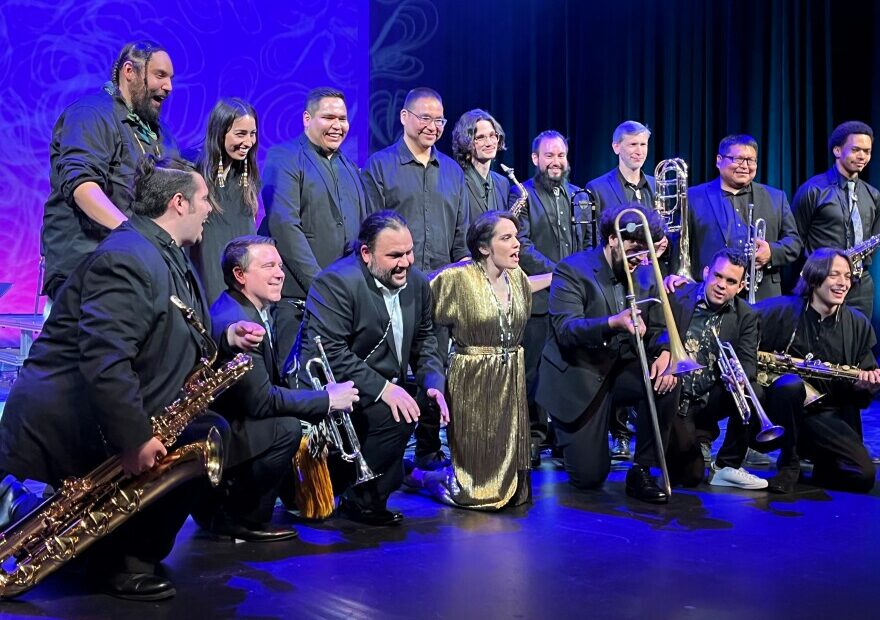
To ‘Honor The Shoulders We Stand On:’ Big Band Premieres With Nod To History Of Native Jazz Musicians
Listen
Correspondent Tom Banse spoke to the band leader and the co-director of a 16-piece, all-Native big band. Here they are in their own words. (Runtime 4:42)
Read
A scheme to entertain a 4-year-old youngster in Spokane by playing a jazz album nearly three decades ago produced a cascade of aftereffects that culminated on stage in Olympia, Washington, this month with crescendos of horns and multiple standing ovations. During the debut of a 16-piece, all-Indigenous big band, the performers on stage hearkened even further back in history to celebrate the little-known, but long line of Native jazz musicians and big bands.
Band leader Julie Keefe, a Nez Perce tribal member, traced the beginning of the chain of events to her early childhood when she listened to a record of jazz and swing great Billie Holiday.
“I just remember as a kid being completely enchanted by Billie’s sound and also her sound within the context of a large ensemble,” Keefe said in an interview before the May 19 premiere of her own big band.
Keefe said it wasn’t until very late in high school that she herself first sang with the backing of a big band, then composed of her Gonzaga Prep Jazz Band classmates. Keefe now works as a professional jazz vocalist based in Brooklyn, New York.
“Putting together a big band has definitely been in the back of my mind ever since my high school days and well before,” she said. “It was always something I wanted to do, but I never anticipated having the opportunity.”
The coronavirus pandemic, which has been so hard on artists and cultural organizations, resulted in the dream being realized in a roundabout way. Donors and foundations have tried to keep arts and culture afloat with grants and relief programs. Keefe applied for and received a $40,000 grant to launch the Julie Keefe Indigenous Big Band back home in Washington state. The support came from the nonprofit South Arts, which is funded by the Doris Duke Charitable Foundation with additional support from the Andrew Mellon Foundation.
Then the question became how to fill out a 16-piece band, Keefe and band co-director Delbert Anderson recalled.
“Are there even 16 Native/Indigenous jazz musicians out there who would want to do this?” Keefe said. “It was astounding the response we got.”
Keefe and Anderson said they could have assembled two all-Native big bands with the talent that came out of the woodwork. The selected participants had connections to Native peoples across the Americas, including Alaska, Hawaii, eastern Canada, the U.S. Southwest, the Great Plains and Caribbean.
“Right away from the first rehearsal, everyone had this one spirit mindset,” said Anderson, who is from the Diné tribe of the Navajo Nation. “You know just in general, Indigenous history isn’t that great. But you always hear the stories of them moving forward. I think every Indigenous person believes and knows that we all carry that forward spirit. I really wanted to join just to be with a clique or a group of Indigenous musicians who get that idea.”
“We hope this is the beginning of something powerful,” Keefe said as she greeted the enthusiastic audience at the premiere held in the capacious Washington Center for the Performing Arts in downtown Olympia. On stage, she sported a shimmering gold dress and high heels with the band arrayed behind her in matching charcoal suits and togs.
Keefe went on to describe how the group wanted to “honor the shoulders we stand on,” a reference to the long line of Native jazz musicians that preceded her generation.
“One of the things that came out of Indian boarding schools for those that survived was a knowledge of Western music,” Keefe said. “There were Indigenous big bands on reservations all over the country. There were small ensembles all over the country. From my own tribe, we had the Nez Perceans and the Lollipop Six.”
“It’s a history that is often forgotten,” she continued. “We want to try to correct that. That is one of our missions – to honor those who allowed us to be here, but to also inspire those yet to come.”
The band’s set list spotlighted historical hits by Oregon-born and raised jazz fusion pioneer Jim Pepper, who was of Kaw and Muscogee Creek heritage, and Depression era singer Mildred Bailey – aka “Mrs. Swing” – who was half Coeur d’Alene.
The unusual, new big band also played a number of modern compositions from its own members, which had thematic inspirations as varied as a prominent Indian Country landmark in New Mexico, the World War II Navajo Code Talkers, and the fraught rules for determining tribal citizenship. The latter piece, “Blood Quantum” by bassist Mali Obomsawin, transitioned from big band melodies to a surprise ending of chanting to the beat of a Native drum.
“Every big band is different,” Anderson remarked. “With the original compositions, they don’t sound anything like your normal jazz big band. It’s very different because it comes from a different place.”
What happens next with the Julia Keefe Indigenous Big Band is unclear. The grant funding only covered a creative residency, rehearsals and the debut performance. Keefe said more grants may be needed to reunite the scattered participants for future gigs. Keefe and her co-directors Anderson and Rico Jones said they would love to see a condensed or expanded version of the band go on tour. A video production crew filmed the mid-May rehearsals and the world premiere, so there is a documentary in the works.
















